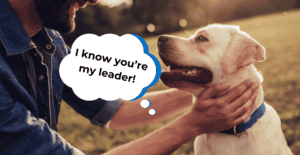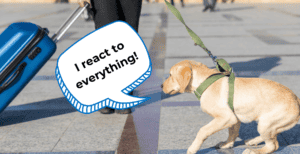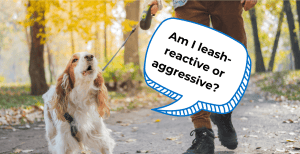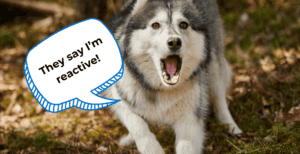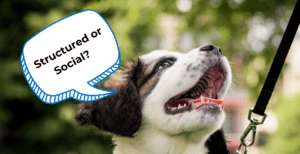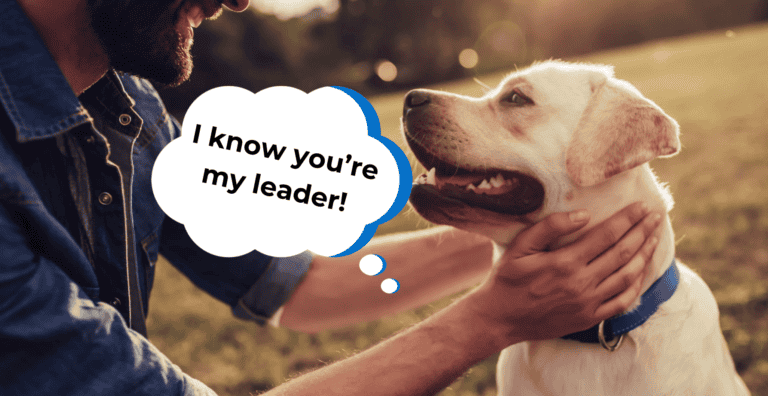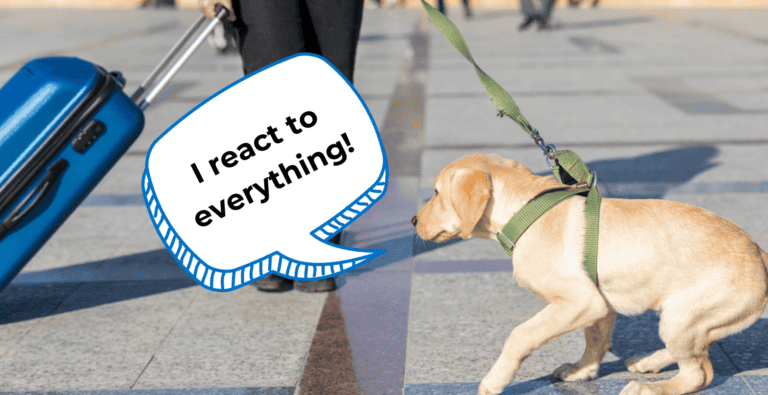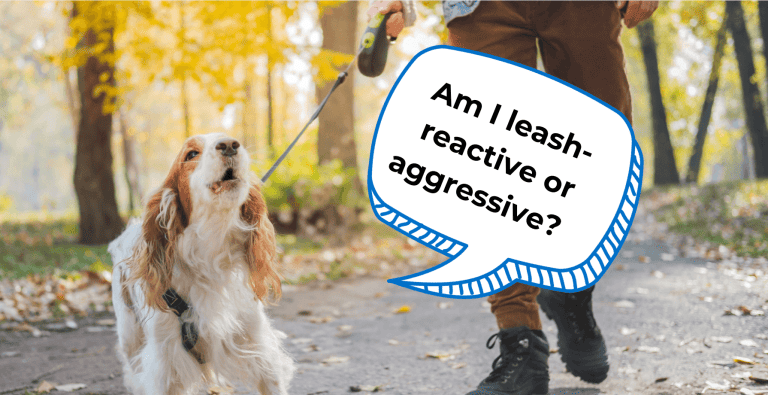If you’re eager to know how to help fearful dogs, I know where you’re coming from. Fearful dogs are exhausted. You can read their exhaustion through their habits and body language: they can’t easily sleep, they’re reactive, and they’re triggered by the littlest things.

If you own a dog that is highly fearful, you already know telling them “Please, calm down” doesn’t work.
So what do you do as a dog owner to truly pacify your dog’s fears?
I’m sharing an IMPORTANT dog trainer tip I’ve learned through the years. Read on to learn more.
Key Takeaways:
- If you want to know what causes dog fears, it’s important to check your fears as well. You can directly influence your dog’s reaction to things!
- Helping fearful dogs overcome their fears starts with letting them see our calm, confident, unfazed energy. When we don’t give attention to things that worry them, it sends a message that they can ignore it, too.
- Becoming the pack leader is an important ingredients to stopping fearful dogs from becoming more stressed!
RAISE CALMER DOGS, BRAVER DOGS WITH THE DOG CALMING CODE!
Table of Contents:
- Dog Owners and Dog Fears: The Story of the Woman with a Reactive Dog
- How to Help Fearful Dogs: The #1 Reason For Your Dog’s Fearful Energy
- Helping Fearful Dogs: Other Reasons Why Dogs Are Afraid
- 10 Signs of a Fearful Dog
- How to Help Fearful Dogs at Home
- How to Help Fearful Dogs Outdoors
- Dog Calming Code: Helping Fearful Dogs Become Calmer and More Confident
Dog Owners and Dog Fears: The Story of the Woman with a Reactive Dog
My heart is close to dogs struggling with fears and anxiety. So when a lady told me that she had a problem with her reactive dog, I recommended a consultation.
When I met them, I couldn’t sense any agitated energy in her dog.
So we started rolling the camera to record the dog’s interactions as part of the consultation.
(And boy, I’m sure glad we did!)
When I asked them to walk, the dog was chill… until they had to walk past my dog.
The woman’s dog snarled, barked, and poised to attack the other dog.

That immediately made me wonder “What caused the change?” I knew the dog was reactive, but the way they shifted from calm to aggressive caught my attention.
We decided to review the tapes to see what caused the change.
And the moment I saw it, I immediately knew the exact reason.
During the walk, both owner and dog carried a happy, calm energy. When the dog had to walk past my dog, the owner did a slight, almost unnoticeable tug on the leash.
A gesture that meant “Hey, there’s a dog and I’m quite worried with what you’re going to do. Don’t come near him.”
And the dog immediately thought “Oh, so that dog is danger!”
The reasonable next step is for the dog to react to the threat — it was their way of protecting their owner from something they think is scary.
WHAT MAKES BETTER, CALMER DOGS? THE DOG CALMING CODE IS THE ANSWER! CHECK IT OUT HERE.
How to Help Fearful Dogs: The #1 Reason For Your Dog’s Fearful Energy
I'm about to share a game-changing secret from my experience as a top dog trainer. When it comes to helping fearful dogs: your energy matters more than you might think.
Now, let's dig deeper with a few questions:
- Have you ever noticed that your fears influence your dog’s fears?
- Do you observe your dog getting more fearful when you’re also feeling anxious or worried?
- Has your dog shown fear toward things THAT SECRETLY SCARE you?
If you find yourself answering “yes” to all these questions, it’s time to understand a fundamental principle: “Energy Flows Where Your Attention Goes.”
What does this mean, exactly?

It means that if you're focused on things that trigger either YOUR fears or YOUR DOG'S fears, there's a good chance your dog will start to fear those things too.
Let me illustrate this with an example:
Think back to the woman I mentioned earlier. When she paid no mind to my dog, her dog remained calm and unbothered.
But the moment she started to react with worry, her dog sensed that worry and began displaying fear-based aggression.
Now, picture a different scenario: What if that woman— instead of panicking — decided to ignore my dog and redirect her dog's attention elsewhere?
Do you think her dog would react with the same level of aggression?
I'd bet my bottom dollar that the dog wouldn't be as aggressive.
In essence, your energy and attention play a pivotal role in shaping your dog's feeling towards certain things.
THE DOG CALMING CODE CAN HELP DOGS BEHAVE BETTER
Helping Fearful Dogs: Other Reasons Why Dogs Are Afraid
Now that I laid out the number one cause for dog’s fears — which is your own fear as a dog owner — it is also important to talk about the other reasons that cause fearful dogs.
Lack of Socialization
Lack of socialization causes fearful dogs because they feel everything and everyone is a stranger to them.

And unfamiliar people and things can cause fear!
Insufficient exposure to different people, animals, environments, and experiences during the critical socialization period (typically between 3 and 14 weeks of age) can lead to fear of the unfamiliar later in life.
Past Trauma or Negative Experiences
Dogs who have experienced trauma, abuse, or negative encounters in the past may carry emotional scars that result in long-lasting fear reactions to certain stimuli or situations.
Genetic Predisposition
Some dogs may have a genetic predisposition to anxiety and fearfulness. Breeds or individual dogs with a more nervous temperament may be prone to fear-related issues.

Medical Issues
Medical conditions that cause pain, neurological problems, or sensory deficits, can make dogs more prone to anxiety and fearful behavior. It's essential to rule out any underlying health concerns when addressing fear in dogs.
Lack of Confidence
Dogs with low self-esteem or a lack of confidence may exhibit fear-based behaviors as a way of coping with unfamiliar or challenging situations.
THIS IS THE DOGGY DAN PROGRAM THAT HAS CHANGED THE LIVES OF 88,000 DOGS!
10 Signs of a Fearful Dog
“Doggy Dan, how can I tell if my dog is starting to absorb my fearful energy? What are the signs of fear in dogs that I should look out for?”
The best way how to help fearful dogs is to know what signs to look for. Here are some examples.
Excessive Cowering or Trembling
Picture your dog on a stormy night, cowering in the corner as thunder rumbles outside. If your dog senses your fear of the sound, your dog may start trembling or retreating in a corner.

Avoidance Behavior
Have you ever seen your dog hide under the bed when the vacuum cleaner comes out? This avoidance behavior shows they're scared of the noisy machine.
Excessive Barking or Whining
Imagine a scenario where your dog encounters a large, unfamiliar dog at the park.
If random dogs startle you, too, your dog may bark and whine as a signal of their unease and discomfort in that situation.
Tail Tucking
Think about when a stranger approaches your dog on a walk, and suddenly, their tail tucks between their legs. This is their way of saying, “I'm scared.”
LEARN HOW TO HELP A FEARFUL DOG BETTER WITH THE DOG CALMING CODE!
Panting and Drooling
After a visit to the vet, your dog might pant excessively or drool due to anxiety. These physical signs can indicate their stress.

Aggression
If your dog growls or snaps when a child gets too close to their food bowl, it's a sign of fear. They feel threatened and react defensively.
Excessive Shedding
During a thunderstorm, your dog might shed more fur than usual due to their anxiety. It's a visible sign of their emotional distress.
Potty Accidents
Consider a situation where you leave your dog home alone for an extended period. When you return, you find a mess on the floor. This can result from their fear of being alone.
Dilated Pupils
When your dog encounters a loud noise like fireworks, their pupils may dilate. This shows they're in a state of fear and arousal.
Lack of Appetite
If your dog suddenly refuses to eat when you introduce them to a new environment, it could be related to their fear of the unfamiliar surroundings.
A CALM DOG STARTS WITH A CALM OWNER. LET THE DOG CALMING CODE HELP YOU BECOME ONE!
How to Help Fearful Dogs at Home
If dogs are within our property, they should feel safe enough to feel protected from any danger, right? Well, that is a common misconception.
You see, the reality is a bit different.

Even when dogs have a loving home, if their owner doesn't establish themselves as the leader of the pack, dogs will think they're in charge of protecting the home themselves.
This can actually lead to some unexpected anxieties and fears in our dogs.
Here are a few examples and how you can help.
Fear of Random Sounds
Any unfamiliar sound is a sign of danger for a dog that feels they are in charge.
I talk about this being one of the fears that dog owners can resolve with the help of the Doggy Dan Rule #3: Dealing with Danger.

In golden rule #3, the solution is simple: you have to show your dog that the random sound doesn’t faze you.
You have to send the message “Don’t you worry about that. It doesn’t worry me. And if that one’s danger, then you can let me worry about it. You just chill out.”
Your dog will feel your confidence as a pack leader, and they will see you’re not fearful at all!
And if your dog feels your calm energy, they can stop worrying, too.
Fear of Other Animals in the Home
To help your dog overcome their fear of other animals, consider introducing them to a new fur-sibling outside your home, such as a park. This neutral environment can facilitate a more relaxed initial meeting.
FROM SOCIALIZATION TO TRAINING WITHOUT FEAR, LEARN THE STRATEGIES WITH THE DOG CALMING CODE
Fear of People
When dealing with your dog's fear of people, it's crucial to approach introductions gradually and with sensitivity.

Begin by having the person your dog is afraid of maintain a calm and non-threatening demeanor. Allow your dog to approach them at their own pace.
How to Help Fearful Dogs Outdoors
Is going out such a stressful thing for your dog? Here are ways you can help.
Anxiety in the Great Outdoors
It's a challenge many dog owners face: your dog might be calm and collected at home, but once you step outside, it's like a whole new world.
Here's the deal: being the pack leader in the comfort of your home is fantastic, but it's equally a must to assume that role outdoors to boost your dog's confidence and security.

As the leader, you take the lead, ensuring that if any potential dangers arise, you're there to face them head-on and handle the situation.
LEARN HOW TO BECOME THE PACK LEADER IN AND OUT OF THE HOUSE. GET THE DOG CALMING CODE NOW!
Fear of Other Dogs in Outdoor Settings
Understanding the social nature of dogs is key to making them feel comfortable around other pups.
Rather than overwhelming your dog with unfamiliar faces at the dog park, focus on regular playdates with a select group of familiar furry friends. This builds positive bonds and reduces anxiety.

Don't forget, your own demeanor matters too! Stay calm when introducing your dog to new pals, as they often take cues from your reactions on how to behave themselves.
Fear of Scary Stuff in Outdoor Environments:
Outdoors can be full of surprises for our dogs.
From strange-looking sticks to crossing streams, these new experiences can sometimes trigger fear in our dogs.
But here's a simple formula to keep in mind when helping dogs navigate through outdoor things that scare them:
First, show your dog that there's no need to be afraid. If you're crossing a stream, demonstrate how it's done calmly and safely. Your confidence can be contagious!

Then, shift their focus to something positive, like their favorite toy or a game of fetch. This helps them build a positive connection with the environment.
Remember, once your dog sees and feels that there's nothing to fear, they'll feel much more at ease.
CONFIDENT OWNER = CONFIDENT DOGS. START NOW WITH THE DOG CALMING CODE.
Dog Calming Code: Helping Fearful Dogs Become Calmer and More Confident
Doggy Dan's Dog Calming Code transforms the lives of owners and their cherished pets!
As an experienced top dog trainer, I know how closely linked an owner's stress and their dog's fears can be.
It's a cycle that feeds off each other, making it vital to address our dogs' fearful behaviors before they turn worse.
Enter the Dog Calming Code, my online training program. Here, you'll discover the key to becoming the calm, confident pack leader in your dog's eyes.
When your dog senses your confidence, it sparks a chain reaction, boosting their own self-assurance.
The Dog Calming Code also equips you with practical knowledge and techniques to effectively ease your dog's fears. It's a holistic approach that cultivates peace and security that you and your dog so deserve!

~ Doggy Dan 😄
Get the first dibs on updates on all things dog related—subscribe to our newsletter here:




